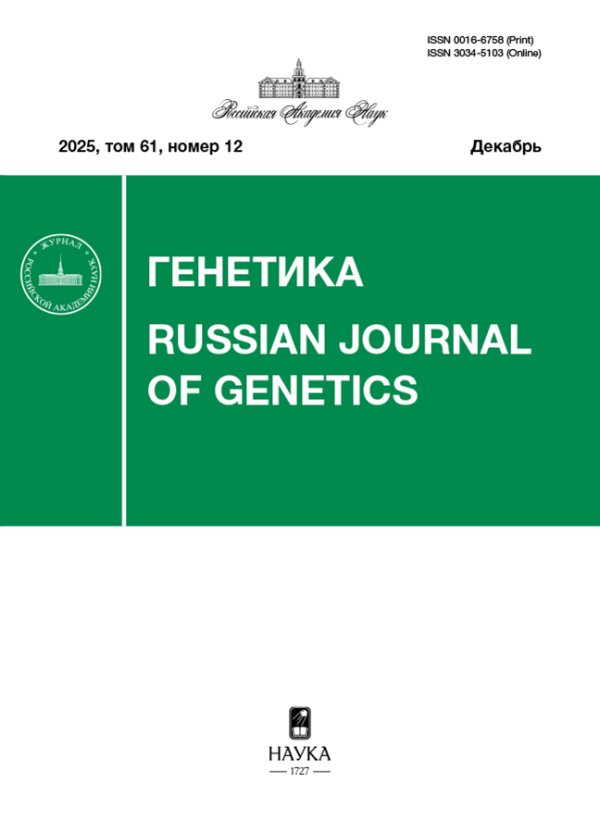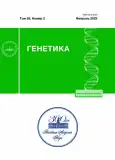Симбиогенетика и симбиогенез: молекулярные и экологические основы интегративной эволюции
- Авторы: Проворов Н.А.1, Тихонович И.А.1,2
-
Учреждения:
- Всероссийский научно-исследовательский институт сельскохозяйственной микробиологии
- Санкт-Петербургский государственный университет
- Выпуск: Том 59, № 2 (2023)
- Страницы: 135-146
- Раздел: ОБЗОРНЫЕ И ТЕОРЕТИЧЕСКИЕ СТАТЬИ
- URL: https://journals.rcsi.science/0016-6758/article/view/134551
- DOI: https://doi.org/10.31857/S0016675823020091
- EDN: https://elibrary.ru/KYCQSQ
- ID: 134551
Цитировать
Полный текст
Аннотация
Симбиогенетика представлена как дисциплина, предметом которой являются объединенные системы наследственности, возникающие в ходе коэволюции неродственных организмов. Изучение этих систем дополняет методологию генетического анализа подходами “генетического синтеза”, направленного на характеристику молекулярных и экологических факторов интеграции гетерологичных геномов. Хологеномы и симбиогеномы, возникающие в процессе интегративной эволюции (симбиогенеза), разделяются, как и пангеномы прокариот, на коровые и акцессорные части. В хологеноме константная по составу коровая часть представлена геномом хозяина (ядерно-цитоплазматической системой наследственности), а вариабельная акцессорная часть – метагеномом микробного сообщества, ассоциированного с хозяином и выполняющего полезные для него функции. Механизмы симбиогенеза выходят за рамки представлений о факторах эволюции свободноживущих организмов и включают: а) межвидовой альтруизм, связанный с отказом симбионтов от автономного существования, а при глубокой редукции – и от способности к самостоятельному поддержанию генома; б) наследование хозяином симбионтов как “благоприобретенных” наследственных детерминант (пангенезис). Под действием этих факторов симбионты могут быть преобразованы во внутриклеточные органеллы хозяина, утратившие генетическую индивидуальность, а иногда и лишенные геномов. Симбиогенез впервые представлен нами как многоэтапный процесс, включающий возникновение: а) геном-содержащей прокариотической клетки; б) мультигеномной эукариотической клетки; в) многоклеточных эукариот как холобионтов, состоящих из организмов-хозяев и поддерживаемых ими микробных сообществ. Безгеномные органеллы, сохранившие базовые жизненные функции – размножение и обмен веществ, могут быть использованы как модели для реконструкции ранних этапов эволюции клетки, включая возникновение ее генома.
Об авторах
Н. А. Проворов
Всероссийский научно-исследовательский институт сельскохозяйственноймикробиологии
Автор, ответственный за переписку.
Email: provorovnik@yandex.ru
Россия, 196608, Санкт-Петербург
И. А. Тихонович
Всероссийский научно-исследовательский институт сельскохозяйственноймикробиологии; Санкт-Петербургский государственный университет
Email: provorovnik@yandex.ru
Россия, 196608, Санкт-Петербург; Россия, 199034, Санкт-Петербург
Список литературы
- Тихонович И.А., Проворов Н.А. Симбиогенетика микробно-растительных взаимодействий // Экол. генетика. 2003. Т. 1. № 0. С. 36–46.
- Тихонович И.А., Проворов Н.А. Развитие подходов симбиогенетики для изучения изменчивости и наследственности надвидовых систем // Генетика. 2012. Т. 48. № 4. С. 437–450.https://doi.org/10.1134/S1022795412040126
- de Bary A. Die Erscheinung der Symbiose. Strassburg: Verlag Von K.J. Trübner, 1879. 30 s.
- Мережковский К.С. Теория двух плазм как основа симбиогенезиса, нового учения о происхождении организмов. Казань: Типо-литография Имп. ун-та, 1909. 102 с.
- Маргулис Л. Роль симбиоза в эволюции клетки. М.: Мир, 1983. 352 с.
- Tikhonovich I.A., Provorov N.A. From plant-microbe interactions to symbiogenetics: a universal paradigm for the inter-species genetic integration // Ann. Appl. Biol. 2009. V. 154. № 3. P. 341–350. https://doi.org/10.1111/j.1744-7348.2008.00306.x
- Лобашев М.Е. Генетика. Л.: Изд-во ЛГУ, 1967. 751 с.
- Benzer S. The elementary units of heredity // The Chemical Basis of Heredity / Eds McElroy W.D., Glass B. Baltimore, Maryland: Johns Hopkins Press, 1957. P. 70–93.
- Инге-Вечтомов С.Г. Введение в молекулярную генетику. М.: Высш. шк., 1983. 343 с.
- Loegering W.Q. Current concepts of inter-organismal genetics // Annu. Rev. Phytopathol. 1978. V. 16. P. 309–320.
- von Bertalanffy L. General System Theory: Foundations, Development, Applications. N.Y.: George Braziller, 1968. 250 p.
- Тихонович И.А., Андронов Е.Е., Борисов А.Ю. и др. Принцип дополнительности геномов в расширении адаптационного потенциала растений // Генетика. 2015. Т. 51. № 9. С. 973–990.https://doi.org/10.1134/S1022795415090124
- Rosenberg E., Zilber-Rosenberg I. The hologenome concept of evolution after 10 years // Microbiome. 2018. V. 6. № 78.https://doi.org/10.1186/s40168-018-0457-9
- Проворов Н.А., Тихонович И.А., Воробьев Н.И. Симбиоз и симбиогенез. С.-Петербург: Информ-Навигатор, 2018. 464 с.
- Андронов Е.Е., Иголкина А.А., Кимеклис А.К. и др. Характеристика естественного отбора в популяциях клубеньковых бактерий (Rhizobium leguminosarum), взаимодействующих с различными видами растений-хозяев // Генетика. 2015. Т. 51. № 10. С. 1108–1116. https://doi.org/10.1134/S1022795415100026
- Igolkina A.A., Bazykin G.A., Chizhevskaya E.P. et al. Matching population diversity of rhizobial nodA and legume NFR5 genes in plant-microbe symbiosis // Ecol. Evol. 2019. V. 9. № 18. P. 10377–10386. https://doi.org/10.1002/ece3.5556
- Shatskaya N.V., Bogdanova V.S., Kosterin O.E. et al. Plastid and mitochondrial genomes of Vavilovia formosa (Stev.) Fed. and phylogeny of related legume genera // Vavilov J. Genet. Breed. 2019. V. 23. № 8. P. 972–980. https://doi.org/10.18699/VJ19.574
- Koga R., Tsuchida T., Fukatsu T. Changing partners in an obligate symbiosis: A facultative endosymbiont can compensate for loss of the essential endosymbiont Buchnera in an aphid // Proc. R. Soc. Lond. B. 2003. V. 270. P. 2543–2550. https://doi.org/10.1098/rspb.2003.2537
- Oda Y., Larimer F.W., Chain P.S. et al. Multiple genome sequences reveal adaptations of a phototrophic bacterium to sediment microenvironments // Proc. Natl Acad. Sci. USA. 2008. V. 105. № 47. P. 18543–18548. https://doi.org/10.1073/pnas.0809160105
- Rey F., Harwood C.S. FixK, a global regulator of microaerobic growth, controls photosynthesis in Rhodopseudomonas palustris // Mol. Microbiol. 2010. V. 75. № 6. P. 1007–1020. https://doi.org/10.1111/j.1365-2958.2009.07037.x
- Проворов Н.А., Онищук О.П., Юргель С.Н. и др. Конструирование высокоэффективных симбиотических штаммов бактерий: эволюционные модели и генетические подходы // Генетика. 2014. Т. 50. № 11. С. 1273–1285. https://doi.org/10.7868/S0016675814110113
- Haag A.F., Arnold M.F., Myka K.K. et al. Molecular insights into bacteroid development during Rhizobium-legume symbiosis // FEMS Microbiol. Rev. 2013. V. 37. № 3. P. 364–383. https://doi.org/10.1111/1574-6976.12003
- Kumar K., Mella-Herrera R.A., Golden J.W. Cyanobacterial heterocysts // Cold Spring Harbor Perspectives in Biology. 2010. V. 2. № 4. a000315.https://doi.org/10.1101/cshperspect.a000315
- Katz L.A. Recent events dominate interdomain lateral gene transfers between prokaryotes and eukaryotes and, with the exception of endosymbiotic gene transfers, few ancient transfer events persist // Philos. Transact. Roy. Soc. Lond. Ser. B. Biol. Sci. 2015. V. 370. № 1678. 20140324.https://doi.org/10.1098/rstb.2014.0324
- Дарвин Ч. Происхождение видов путем естественного отбора. СПб.: Наука, 1991. 539 с.
- Maynard Smith J. Generating novelty by symbiosis // Nature. 1989. V. 341. № 6240. P. 284–285.
- Козо-Полянский Б.М. Новый принцип биологии. Очерк теории симбиогенеза. М.: Пучина, 1924. 156 с.
- Dobzhansky Th. Genetics of the Evolutionary Process. N.Y.: Columbia Univ. Press, 1970. 259 p.
- Jones J.D.G., Dangl J.L. The plant immune system // Nature. 2006. V. 444. № 7117. P. 323–329. https://doi.org/10.1038/nature05286
- Онищук О.П., Воробьев Н.И., Проворов Н.А. Нодуляционная конкурентоспособность клубеньковых бактерий: генетический контроль и адаптивное значение // Прикл. биохимия и микробиология. 2017. Т. 53. № 2. С. 127–135. https://doi.org/10.7868/S0555109917020131
- Sprent J.I. Nodulation in Legumes. Kew Royal Botanical Gardens: Cromwell Press Ltd, 2001. 102 p.
- Denison R.F., Kiers E.T. Lifestyle alternatives for rhizobia: mutualism, parasitism and foregoing symbiosis // FEMS Microbiol. Lett. 2004. V. 237. № 1. P. 187–193. https://doi.org/10.1016/j.femsle.2004.07.013
- Provorov N.A. Genetic individuality and inter-species altruism: Modelling of symbiogenesis using different types of symbiotic bacteria // Biol. Communicat. 2021. V. 66. № 1. P. 65–71. https://doi.org/10.21638/spbu03.2021.108
- Darlington P.J. Altruism: its characteristics and evolution // Proc. Natl Acad. Sci. USA. 1978. V. 75. № 2. P. 385–389.
- Janzen D.H. When is it coevolution? // Evolution. 1980. V. 34. № 3. P. 409–616.https://doi.org/10.1111/j.1558-5646.1980.tb04849.x
- Provorov N.A. Coevolution of rhizobia with legumes: facts and hypotheses // Symbiosis. 1998. V. 24. № 3. P. 337–367.
- Kleinschmidt B., Kölsch G. Adopting bacteria in order to adapt to water – how reed beetles colonized the wetlands (Coleoptera, Chrysomelidae, Donaciinae) // Insects. 2011. V. 2. № 2. P. 540–554. https://doi.org/10.3390/insects2040540
- Проворов Н.А., Тихонович И.А., Воробьев Н.И. Симбиогенез как модель для реконструкции ранних этапов эволюции генома // Генетика. 2016. Т. 52. № 2. С. 137–145. https://doi.org/10.7868/S0016675816020107
- Oberholzer T., Wick R., Luisi P.L., Biebricher C.K. Enzymatic RNA replication in self-reproducing vesicles: An approach to a minimal cell // Biochem. Biophys. Res. Comm. 1995. V. 207. № 2. P. 250–257.
- Kurihara K., Okura Y., Matsuo M. et al. A recursive vesicle-based model protocell with a primitive model cell cycle // Nat. Commun. 2015. V. 6. № 8352. https://doi.org/10.1038/ncomms9352
- Brueckner J., Martin W.F. Bacterial genes outnumber archaeal genes in eukaryotic genomes // Genome Biol. Evol. 2020. V. 12. № 4. P. 282–292. https://doi.org/10.1093/gbe/evaa047
- Douglas A.E. The molecular basis of bacterial–insect symbiosis // J. Mol. Biol. 2014. V. 426. № 7. P. 3830–3837. https://doi.org/10.1016/j.jmb.2014.04.005
- Ku C., Nelson-Sathi S., Roettger M. et al. Endosymbiotic gene transfer from prokaryotic pangenomes: inherited chimerism in eukaryotes // Proc. Natl Acad. Sci. USA. 2015. V. 112. № 33. P. 10139–10146.https://doi.org/10.1073/pnas
- Famintzin A.S., Baranetzky O.V. Zur Entwickelungsgeschichte der Gonidien und Zoosporenbildung der Flechten // Mémoires de l’Académie imp. des sciences de St.-Pétersbourg, 7 serié. 1867. V. 11. № 9.
- Фаминцын А.С. О роли симбиоза в эволюции организмов // Зап. Имп. акад. наук, физ.-мат. отд. Серия 8. 1907. Т. 20. № 3. С. 1–14.
- Проворов Н.А. К.С. Мережковский и происхождение эукариотической клетки: 111 лет теории симбиогенеза // Сельскохоз. биология. 2016. Т. 51. № 5. С. 746–758. https://doi.org/10.15389/agrobiology.2016.5.746rus
- Sagan D. From Empedocles to Symbiogenetics: Lynn Margulis’s revolutionary influence on evolutionary biology // BioSystems. 2021. V. 204:104386.https://doi.org/10.1016/j.biosystems.2021.104386
- Инге-Вечтомов С.Г. Ретроспектива генетики. СПб.: Изд-во Н-Л, 2015. 336 с.
- Проворов Н.А. Симбиогенез как эволюция генетических систем открытого типа // Генетика. 2018. Т. 54. № 8. С. 879–889. https://doi.org/10.1134/S0016675818080106
- Пронозин А.Ю., Брагина М.К., Салина Е.А. Пангеномы сельскохозяйственных растений // Вавил. журн. генетики и селекции. 2021. Т. 25. № 1. С. 57–63. https://doi.org/10.18699/VJ21.007
Дополнительные файлы













